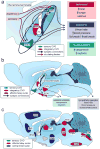Thirst
- PMID: 27997832
- PMCID: PMC5957508
- DOI: 10.1016/j.cub.2016.11.019
Thirst
Abstract
Our bodies are mostly water, and this water is constantly being lost through evaporative and other means. Thus the evolution of robust mechanisms for finding and consuming water has been critical for the survival of most animals. In this Primer, we discuss how the brain monitors the water content of the body and then transforms that physical information into the motivation to drink.
Copyright © 2016 Elsevier Ltd. All rights reserved.
Figures




References
-
- Antunes-Rodrigues J, De Castro M, Elias LLK, Valença MM, McCann SM. Neuroendocrine control of body fluid metabolism. Physiol Rev. 2004;84:169–208. http://dx.doi.org/10.1152/physrev.00017.2003. - DOI - PubMed
-
- Bourque CW. Central mechanisms of osmosensation and systemic osmoregulation. Nat Rev Neurosci. 2008;9:519–531. http://dx.doi.org/10.1038/nrn2400. - DOI - PubMed
-
- Burg MB, Ferraris JD, Dmitrieva NI. Cellular response to hyperosmotic stresses. Physiol Rev. 2007;87:1441–1474. http://dx.doi.org/10.1152/physrev.00056.2006. - DOI - PubMed
-
- Cannon WB. The physiological basis of thirst. Proc R Soc Lond B: Biol Sci. 1918;90:283–301. http://rspb.royalsocietypublishing.org/cgi/doi/10.1098/rspb.1918.0017. - DOI
-
- Fitzsimons JT. Thirst Physiol Rev. 1972;52:468–561. http://physrev.physiology.org/content/52/2/468. - PubMed
MeSH terms
Grants and funding
LinkOut - more resources
Full Text Sources
Other Literature Sources
Medical

